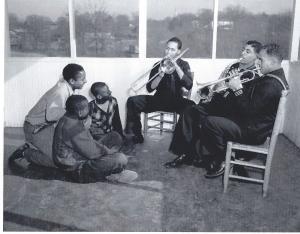Our Community. Our Stories.
"As long as it’s a struggle, I know you’re trying."
Mr. Harold Foster
Tap into eight generations of joy and struggle here. Explore images and themes.

A Place at the Table: Food Histories
Builders

Business

Celebrations

Civil Rights in Chapel Hill, Photographs by Jim Wallace

Education

Facing Our Neighbors
Who are our neighbors? What makes a neighborhood strong? How can and should we be neighbors in the face of rapid change?
In the historic "Northside" area of Chapel Hill / Carrboro, North Carolina, economic development, food insecurity, and homelessness are on the rise. Home ownership is on the downswing; student rentals are popping up everywhere; truly affordable housing is hard to come by. Formerly segregated neighborhoods are becoming increasingly diverse. In the spring of 2010, university students and friends and staff of the Jackson Center for Saving and Making History began to ask people who live and work around the historic Northside of Chapel Hill / Carrboro about the nature and future of the neighborhood. One result was an interactive exhibit and May Day Festival of which this online exhibit is but a token.
You'll see here portraits of some of our neighbors, reflections by others, and excerpts from poems by local youth about what it means to live together in a changing world.
Faith

Food

Hargraves Community Center
History of Homes

Life Histories

Music
Student Projects

Teachers, Artisans, and Entrepreneurs: Black Work in a Southern Town
Welcome to Teachers, Artisans, and Entrepreneurs: Black Work in a Southern Town. Join us in a virtual exhibit that takes you through different locations in Chapel Hill to learn about the ingenuity necessary to creating and sustaining a thriving economy for Black Chapel Hill/Carrboro.
For generations, the Black population in southern Orange County has been part of a vast labor network. Their labor has supported and cared for community members near and far. Formal and informal labor helped neighbors create an independent economy that helped them fight against white supremacy. Black workers are changemakers. Together, they have brought an enormous amount of creativity and care to their work, building a community of abundance.
Thank you to Clementine Self and Reverend Albert Williams for sharing their knowledge and providing critical feedback, and to Kimber Heinz and Scaffold Exhibits & Consulting.
The Marian Cheek Jackson Center received an American Rescue Plan Humanities Grant from North Carolina Humanities, www.nchumanities.org. Funding for this grant was provided by the National Endowment for the Humanities (NEH) as part of the American Rescue Plan Act economic stabilization plan.
Along with NC Humanities, this exhibit was made possible by generous grants from the National Endowment for the Humanities and the Mellon Foundation.


The Freedom Movement

The Northside News

The Struggle Continues: Weaving Histories, Stories, Lives
The images in this digital exhibit were part of a physical exhibit produced by the Jackson Center in happy collaboration with the Chapel Hill Public Library. All of the documentary portraits of Northside neighbords were produced under the direction of their subjects. Many of the topics and people represented in this exhibit have done oral history interviews with the Jackson Center and they are available within this site. All of the images from Chapel Hill High School students were developed in collaboration with Holly Loranger's U.S. History: Arts Focus course at Chapel Hill High. The images from and of students K-8 are part of the Jackson Center's archive of images from its Learning Across Generations curriculum, a series of oral and local history workshops offered in area classrooms and on-site in Northside neighborhoods. The Jackson Center is indebted to Jim Wallace for the donation of over one hundred prints of photos he took as a photographer for UNC's Daily Tar Heel in the early 1960s. A selection of these photos are featured in his book Courage in the Moment: The Civil Rights Struggle, 1961-1964.
